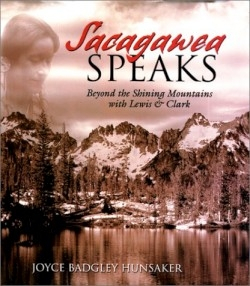Sacagawea Speaks
Beyond the Shining Mountains with Lewis and Clark
“The object of your mission is to explore the Missouri River and such principal stream of it as… may offer the most direct and practicable water communication across the continent, for the purpose of commerce,” instructed President Jefferson in 1803. Lewis and Clark started their expedition that summer. In 1804 a man by the name of Charbonneau offered his services as an interpreter. His wife was Sacagawea.
Sacagawea, meaning “Bird Woman,” was born a Shoshone girl around 1789. At about age eleven, she was taken from her tribe and raised as a servant and eventually a tribal member of the Minnataree (Hidatsa) Nation. She learned at least two tribal languages. The Minnataree conducted fur trade with the French who were in search of expanding commerce. Though it’s uncertain that Sacagawea spoke French, she would certainly have heard it frequently.
When she was barely fourteen years old, she became the second wife of a trapper, a French-and-Indian man named Charbonneau. His mastery of the French and Minnataree languages, plus Sacagawea’s knowledge of Minnataree and Shoshone, made the couple a desirable addition to the expedition. Lewis and Clark, having heard that the Shoshone had many fine horses, wished to purchase some to cross the final stretch to the Pacific. Sacagawea, now sixteen or seventeen, was due to give birth to her first child when her husband agreed to make the trip. Their son was two months old when they left the Minnataree village in North Dakota in April of 1805.
Meriwether Lewis was a close friend of Thomas Jefferson and was charged with keeping careful records and journals for the president. William Clark had been in command over the younger Lewis in the Revolutionary War, and the two became friends. The expedition was to define the lay of the land and navigable rivers, and to contact the tribal nations to the west of the “known world,” over the “shining mountains” of the Rockies.
Despite her youth and the distractions of a newborn, Sacagawea soon became so indispensable that when the expedition considered sacking Charbonneau at one point for insubordination, they never even discussed letting his wife go. She was as hardy as many of the men, and her exceptional exploits as a guide, interpreter, diplomat, and general hand-around-camp were intensified by her roles as wife and mother. It is thought that her knowledge of existing trails helped in the success of the expedition. The author’s fictionalized first-person perspective of this courageous young woman places readers right on the trail with her.
Hunsaker’s twenty years as a nationally acclaimed historical interpreter and storyteller provide a credible voice in this narrative. Her ancestors were members of the Sioux and Cherokee Nations, and she holds the significant honor of being a veteran of the Sun Dance. Additionally, her account has won acclaim from descendants both of Sacagawea herself, and of other members of the expedition. Hunsaker successfully combines the events from the journey’s logs, kept by Lewis and Clark, with the possible thoughts and reflections of the incredibly tough and terribly young Sacagawea. One hears this story in her voice, with documentative interjections from the leaders of the expedition.
The many footnotes add interesting detail, such as an extensive vocabulary of Shoshone words and phrases. Many of the items photographed are not moldering museum pieces but contemporary objects—cradle boards and moccasins—created by living descendants of Sacagawea and her generation, startling in their newness and beauty. Places are depicted both in historic photos and in their current state. Also included are a timeline; an expedition supply list, complete with photos of weaponry used; and an expedition roster listing all documented participants, down to the cadre of privates, each with a biographical paragraph.
Also commendable is an explanation of the intense, intricate relations among tribal nations and bands. Because the narrative flows through the imagined eyes of a Native woman, the subtle and highly important differences among the First Nations are given their due import. Sacagawea would have been well schooled in reading these nuances, and Hunsaker, herself a tribal woman, is also well aware of these enduring cultural inflections, some two hundred years later.
Sacagawea died in 1884 but she lives on in the hearts of historians and all who admire her courage.
Reviewed by
Gabrielle Shaw
Disclosure: This article is not an endorsement, but a review. The publisher of this book provided free copies of the book to have their book reviewed by a professional reviewer. No fee was paid by the publisher for this review. Foreword Reviews only recommends books that we love. Foreword Magazine, Inc. is disclosing this in accordance with the Federal Trade Commission’s 16 CFR, Part 255.


